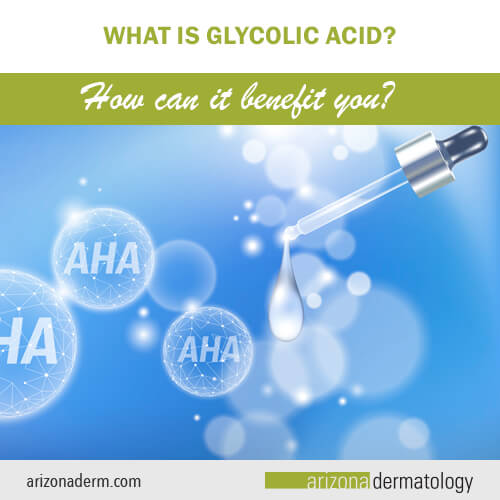 Glycolic acid. You’ve heard about it on TV and read about it in magazines, but what exactly is glycolic and what can it do for you?
Glycolic acid. You’ve heard about it on TV and read about it in magazines, but what exactly is glycolic and what can it do for you?
Glycolic acid first became popular in the 1990s due to its effectiveness and affordability. It is now one of the most common ingredients used in chemical peels and can even be found in over-the-counter face washes and skin creams. One of the so-called “fruit acids,” glycolic acid is an alpha-hydroxy acid (AHA) derived from the sugarcane plant (yes, it’s natural!). Dermatologists love it because it has so many benefits and is well tolerated by most people. Let’s take a closer look at some of the benefits glycolic acid can have on your skin.
Glycolic acid makes a great chemical peel.
If your dermatologist offers you an in-office chemical peel, it may very well contain glycolic acid. Like all AHAs, glycolic acid works by “un-gluing” the stubborn topmost layers of dead skin cells, revealing the newer, healthier skin underneath. Because of its smaller molecular size, glycolic acid is able to better penetrate into the deeper layers of the skin than other AHAs. Glycolic acid chemical peels are available in a variety of strengths, from light (superficial) to medium. Here at Arizona Dermatology, our glycolic acid peel is one of our most popular peels!
Glycolic acid is an effective treatment for acne.
Blackheads, whiteheads and pimples occur when pores become clogged with dirt, oil and dead skin cells. As an exfoliant, glycolic acid loosens and removes the material clogging pores, leading to fewer flare ups and smoother, unblemished skin. The tiny molecules are able to penetrate deep into hair follicles as well, treating areas that other acne products might not be able to reach.
Glycolic acid can help fade scars and reverse sun damage.
Just as it breaks down the glue holding dead skin cells together, glycolic acid also breaks down the raised tissue that forms scars. Over time with glycolic acid treatments, scars become smoother and less visible. It also works to remove the discoloration caused by acne scarring and the dullness and hyperpigmentation caused by sun damage.
Glycolic acid has anti-aging benefits.
Besides helping to clear up acne, erase scars and expose younger, healthier skin, glycolic acid actually helps skin look younger by boosting collagen production. Collagen is the protein that gives skin its structure and elasticity. Introducing glycolic acid into the dermis results in fewer fine lines and wrinkles and firmer, smoother, younger-looking skin.
Glycolic acid helps other skin products work better.
We dermatologists also love to use glycolic acid as a prepping agent for other treatments. By clearing out dead skin cells and sebum from pores ahead of time, acne medications and anti-aging treatments performed in our offices are able to reach deeper into skin layers for better and longer-lasting results.
Using glycolic acid
While it’s easy to find glycolic acid in over-the-counter the products, in many cases the concentration of glycolic acid is too low to get the kind of results you are looking for. Face washes may have 8% to 10%, creams may have up to 15%. An at-home peel, for safety reasons, shouldn’t be more than 30% glycolic acid, while a dermatologist can offer peels with strengths up to 70%. Talk to your dermatologist about how the benefits of glycolic acid can be maximized for you.
Glycolic acid concerns
While glycolic acid is generally considered safe for most skin types, it does tend to dry out skin, so be sure to pair its use with a good moisturizer. Glycolic acid can also make you more sensitive to the sun, so it’s not recommended for people who spend a lot of time outdoors, and if you are planning a day at the beach, a good sunscreen is a must! People with more sensitive skin may experience a tingling sensation when glycolic acid is applied. If the tingle turns into a burn, it’s time to wash the product off.
Want to know more about glycolic acid? Make an appointment with one of our team today.


